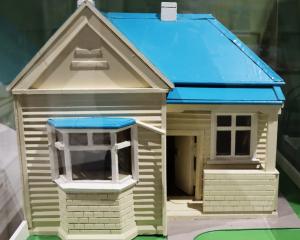The Perrys' stylish home met all their needs, writes David Murray.
This elegant Arts and Crafts-style house was designed by Roy Fraser, of Mandeno & Fraser, and begun just months after the completion of that architectural partnership's best-known project: the nearby Dunedin Town Hall.
The house draws from English domestic architecture, with imaginative combinations of forms, and many charming touches such as contrasting gable ends, an oriel window, copper work, and patterned brickwork.
This last element can be seen in other Mandeno & Fraser designs, such as the Central Fire Station, Speight's Brewery, and a more modest house at 27 London St.
The frontage comes right to the street line, giving the house a strong urban quality, emphasised by its close relationship with the flats next door, which were designed by Coombs & White in 1926.
The building was originally the Perry family home, and included the professional rooms of Dr Arnold Perry (1899-1977). Perry was born in Wellington and trained at the Otago Medical School and in London, where he married Lygia Duthie in 1926.
After returning to Dunedin the following year, he worked at Dunedin Hospital, taught at the Otago Medical School, and established a private practice. Stuart St was an ideal central location for a new family home.
The builders W.H. Naylor Ltd submitted a tender on November 21, 1930 and their final account, dated November 4, 1931, was for 3226. The architects' fees were not settled until 1933.
The family's living areas were at the rear of the house, where extensive glazing exploited the sun and garden views. The surgery and waiting room had a separate entrance (now blocked) facing Stuart St, while a private entrance was on the west side of the house. An addition to the surgery built in 1939 extended over the path between the house and the neighbouring flats.
The interior draws from both the Arts and Crafts and Art Deco styles. Leadlights incorporate geometric patterns, and a feature window depicts a medieval soldier above the motto Fide et Fiducia (Strength and Loyalty), in a design more fanciful than truly heraldic. The bathroom was modern for its time, with yellow tiles, terrazzo flooring and a streamlined bathtub.
Aileen Fenton remembers a very happy childhood as the middle of three Perry children, and the following descriptions of life in the house are based on reminiscences she has kindly supplied.
Arnold (known as Fred) Perry had a busy general practice, combined with obstetrics and gynaecology and hospital work. Patient consultations were usually late morning, and evening from 6.20pm (dinner was at 6pm sharp). The nurse was like part of the family and Mrs Perry often looked after patients' small children while parents had appointments.
During the severe polio epidemic of 1938-39, because of possible infection, Mrs Perry and the children spent two months at the family crib at Taieri Mouth. At other times family outings would be cancelled because a patient had come into labour, so a picnic would be unpacked and had on the back lawn instead.
The sunny back garden was an oasis, and both Dr and Mrs Perry were keen gardeners. Dr Perry was particularly fond of his rose garden, and in the centre of the lawn was a weeping elm where family enjoyed picnicking and playing.
The dining room was the hub of the house, with a table alcove, bookshelves, bay window and a bevelled mirror over a cosy and efficient fireplace that was stoked all day long in winter. Always warm and sunny, the room opened into the playroom or sunporch which had access to the garden.
A live-in maid had her bedroom above the surgery, facing the street, and in the kitchen were bells for communication. The kitchen was dark, as the windows were close to the brick wall of the house next door, but permission was obtained to paint part of the wall white to lighten the room.
A mottled green cast-iron gas stove on legs stood in an alcove in the kitchen, and there was much excitement when a fridge was eventually installed.
Off the kitchen was a laundry with two huge concrete tubs and a large copper. The washing machine and wringer were exciting additions.
Beside the front door was a staircase and the third-top step creaked, so younger members of the family had to be careful coming home late to avoid disturbing their parents!
A coat storage cupboard under the stairs was a great repository for preserves such as Vaselined eggs, bags of Central Otago walnuts, large tins of honey and preserved fruit. It was also a great hiding place for children.
Dr Perry was a rugby man who played for University A and Otago, and one match for the All Blacks (against New South Wales), and was later involved with the game as a doctor and administrator.
After Carisbrook matches on Saturdays the house was often full of rugby players and followers. Formal parties and bridge evenings were held in the north-facing sitting room, where a fireplace was a focal point and an alcove had been fashioned in one wall to showcase a Chiparus figure.
Following the outbreak of war in 1939, Dr Perry joined HMS Achilles as ship's surgeon. He was stationed at Devonport Naval Base, as director of naval medical services, and after the war continued to serve in the Naval Reserve, promoted to the rank of surgeon captain.
In 1946 Dr Perry was appointed to the staff of Dunedin Hospital and the Otago Medical School, and became medical superintendent of the Salvation Army's Maternity Hospital of Redroofs. When he retired in 1971 he was awarded the Distinguished Service Order, having earlier received an OBE.
The Perrys lived in the house up to about 1969. The architecture firm McCoy &Wixon has occupied the building since 1973, and designs for many notable Otago building projects from the past 40 years were planned and developed here.
The layout is not ideal for their busy practice, but the building has served them well and has been beautifully maintained and preserved.
For more from David Murray, go to builtindunedin.com.












